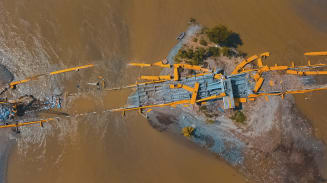More Like This
-
Capability Overview
Supply Chain Risk Management
-
Capability Overview
Climate Risk Advisory
-
Capability Overview
Workplace Wellbeing

Climate volatility and extreme weather events are disrupting global trade routes, impacting supply chain reliability and leading to financial losses. The interconnectedness of trade today adds complexity to the already-challenging exercise of mapping supply chains and mitigating exposures. It’s not uncommon for an event in one region to have downstream impacts on a business on the other side of the world.
Natural catastrophes and impacts of climate extremes can further exacerbate financial and reputational challenges when overlain with other geopolitical and socioeconomic risks. For example, increasing construction expenses, coupled with a shortage of skilled labor and supply chain disruptions, have driven up the costs of rebuilding efforts in the wake of natural disasters.
As the frequency and severity of climate events continue to rise, it’s crucial for businesses to integrate climate risk assessments into their strategic planning. The need for climate-resilient infrastructure and diversified supply chains is likewise becoming more pressing.
Capability Overview
Supply Chain Risk Management
Capability Overview
Climate Risk Advisory
Capability Overview
Workplace Wellbeing
Climate-related events in recent years have had widespread repercussions for global trade:
Global natural disasters in 2024 resulted in economic losses reaching at least $368 billion.
Source: Aon's 2025 Climate and Catastrophe Insight
Beyond regional exposures to climate volatility and extreme weather, the impacts of these risks on businesses vary widely across industries. Two notable sectors impacted by a changing climate include:
Climate volatility and severe weather events like droughts and heatwaves are causing crops to fail, reducing yields and creating food shortages. Studies suggest that on average, yields of key crops have already declined by around 5 percent.5 This trend is even more pronounced for luxury crops, such coffee and cocoa, which are particularly sensitive to temperature changes and typically sourced from countries facing extreme temperatures, droughts and flooding.

Article
In Central America, coffee yields have decreased by over 10 percent, contributing to a 40 percent year-over-year increase in coffee prices.6 Colombian farmers, who often lack insurance and financial safety nets, face prolonged recovery periods after such events that lead to supply chain disruptions.
As prices for these and other crops rise, so too does cargo risk. Agricultural shipments now cost more and supply chain delays — in part caused by weather events — can exacerbate this risk, as agricultural shipments are vulnerable to spoilage.
The rail industry is a critical component of the supply chain. Any disruption can significantly impact the economy and the transport of goods. Moreover, companies in the industry often rely on a handful of global suppliers for critical components, exposing them to unique challenges.
Large weather events, such as hurricanes and wildfires, have caused substantial losses for railroads. U.S. hurricanes in 2024 alone led to significant business interruption losses and costly infrastructure damage, with the cost of replacing a mile of railway track ranging from $1 million to $2 million.
Wildfires in North America have also become a significant concern for the rail industry and are now considered a catastrophic exposure, according to Otis Tolbert, Aon’s global industry specialty leader for rail. “This change has financial implications for clients as their deductibles for wildfire damage can now reach $100 million, up from $25 million in the past,” he says.
Amid a changing climate, insurance solutions like parametric insurance can help organizations transfer the risk of weather-related disruptions. With the volatility, frequency and severity of climate events expected to rise, here are additional risk management strategies businesses can integrate to remain resilient:
Aggregated effects of extreme weather, especially drought and flooding, resulted in nearly $6.7 billion in crop insurance payouts in 2024.
Source: Aon's 2025 Climate and Catastrophe Insight
1 Measuring the supply chain impact of the LA fires, ASU News
2 National Hurricane Center Tropical Cyclone Report: Hurricane Helene, NOAA
3 The Impact of Hurricane Helene on Fifth District Businesses, Federal Reserve Bank of
Richmond
4 Bangladesh: Impact of the floods on agricultural livelihoods and food security in the eastern
part of the country, FAO
5 How will climate change affect crop yields in the future?, Our World in Data
6 2025 Climate and
Catastrophe Insight, Aon
General Disclaimer
This document is not intended to address any specific situation or to provide legal, regulatory, financial, or other advice. While care has been taken in the production of this document, Aon does not warrant, represent or guarantee the accuracy, adequacy, completeness or fitness for any purpose of the document or any part of it and can accept no liability for any loss incurred in any way by any person who may rely on it. Any recipient shall be responsible for the use to which it puts this document. This document has been compiled using information available to us up to its date of publication and is subject to any qualifications made in the document.
Terms of Use
The contents herein may not be reproduced, reused, reprinted or redistributed without the expressed written consent of Aon, unless otherwise authorized by Aon. To use information contained herein, please write to our team.
Our Better Being podcast series, hosted by Aon Chief Wellbeing Officer Rachel Fellowes, explores wellbeing strategies and resilience. This season we cover human sustainability, kindness in the workplace, how to measure wellbeing, managing grief and more.
Expert Views on Today's Risk Capital and Human Capital Issues
Expert Views on Today's Risk Capital and Human Capital Issues
Expert Views on Today's Risk Capital and Human Capital Issues
The construction industry is under pressure from interconnected risks and notable macroeconomic developments. Learn how your organization can benefit from construction insurance and risk management.
Stay in the loop on today's most pressing cyber security matters.
Our Cyber Resilience collection gives you access to Aon’s latest insights on the evolving landscape of cyber threats and risk mitigation measures. Reach out to our experts to discuss how to make the right decisions to strengthen your organization’s cyber resilience.
Our Employee Wellbeing collection gives you access to the latest insights from Aon's human capital team. You can also reach out to the team at any time for assistance with your employee wellbeing needs.
Explore Aon's latest environmental social and governance (ESG) insights.
Our Global Insurance Market Insights highlight insurance market trends across pricing, capacity, underwriting, limits, deductibles and coverages.
How do the top risks on business leaders’ minds differ by region and how can these risks be mitigated? Explore the regional results to learn more.
Our Human Capital Analytics collection gives you access to the latest insights from Aon's human capital team. Contact us to learn how Aon’s analytics capabilities helps organizations make better workforce decisions.
Explore our hand-picked insights for human resources professionals.
Our Workforce Collection provides access to the latest insights from Aon’s Human Capital team on topics ranging from health and benefits, retirement and talent practices. You can reach out to our team at any time to learn how we can help address emerging workforce challenges.
Our Mergers and Acquisitions (M&A) collection gives you access to the latest insights from Aon's thought leaders to help dealmakers make better decisions. Explore our latest insights and reach out to the team at any time for assistance with transaction challenges and opportunities.
How do businesses navigate their way through new forms of volatility and make decisions that protect and grow their organizations?
Our Parametric Insurance Collection provides ways your organization can benefit from this simple, straightforward and fast-paying risk transfer solution. Reach out to learn how we can help you make better decisions to manage your catastrophe exposures and near-term volatility.
Our Pay Transparency and Equity collection gives you access to the latest insights from Aon's human capital team on topics ranging from pay equity to diversity, equity and inclusion. Contact us to learn how we can help your organization address these issues.
Forecasters are predicting an extremely active 2024 Atlantic hurricane season. Take measures to build resilience to mitigate risk for hurricane-prone properties.
Our Technology Collection provides access to the latest insights from Aon's thought leaders on navigating the evolving risks and opportunities of technology. Reach out to the team to learn how we can help you use technology to make better decisions for the future.
Trade, technology, weather and workforce stability are the central forces in today’s risk landscape.
Our Trade Collection gives you access to the latest insights from Aon's thought leaders on navigating the evolving risks and opportunities for international business. Reach out to our team to understand how to make better decisions around macro trends and why they matter to businesses.
With a changing climate, organizations in all sectors will need to protect their people and physical assets, reduce their carbon footprint, and invest in new solutions to thrive. Our Weather Collection provides you with critical insights to be prepared.
Our Workforce Resilience collection gives you access to the latest insights from Aon's Human Capital team. You can reach out to the team at any time for questions about how we can assess gaps and help build a more resilience workforce.

Article 8 mins
In today's intricate business environment, growth is expanding to include more than financial success. By understanding how to fund, shape and secure growth, organizations can build resilience and drive long-term value.

Article 4 mins
Organizations can demonstrate their commitment to global sustainability and a low-carbon future by addressing verification challenges and adopting best practices.

Article 15 mins
Market stability prevails in management liability lines as insurers continue to seek market share. However, expanding technologies, increased litigation and macroeconomic factors are causing growing uncertainty and underwriting concerns.